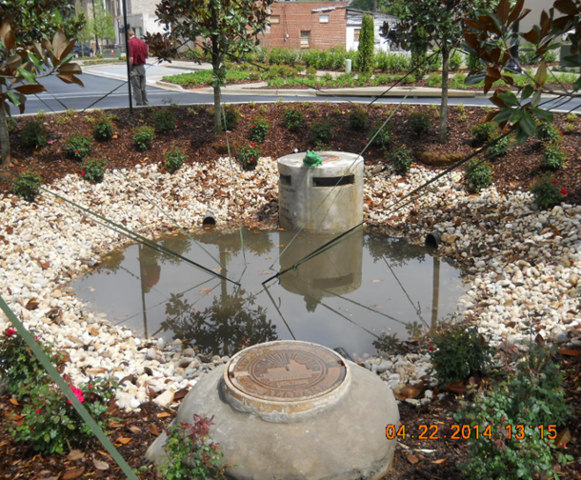What is low impact development?
Low impact development (LID) is a design approach for managing stormwater runoff. It emphasizes conservation and the use of on-site natural features to protect water quality. LID includes engineered practices that are designed to mimic natural hydrology by infiltrating stormwater runoff into the ground, evapotranspiration (uptake of water by plants) in landscaped areas, or capturing and reusing the runoff through rainwater harvesting techniques. Property owners are responsible for the long-term maintenance of all post-construction BMP features including low impact development.
How is the City of Tuscaloosa implementing LID?
The City has been recognized as a leader in the state for LID implementation and encourages developers and residents to consider the use of low impact development and green infrastructure on their projects. The City of Tuscaloosa has permitted over 200 LID post-construction controls since April 27, 2011.
Below are some examples of LID:

Permeable Pavers - Permeable pavers are a system of concrete pavers with layers of varying-sized stone – or aggregate – underneath that filter and direct storm water to underground aquifers. Permeable pavers are used as a way to control stormwater on developed sites. Any rain that falls on the permeable paver patio, walkway or driveway percolates between the pavers and, depending on the soil type, the water infiltrates back into the ground and/or slowly releases to the nearest storm sewer or waterway.

Rain Garden - A rain garden is a planted depression or a hole that allows rainwater runoff from impervious urban areas such as roofs, driveways, walkways, parking lots and compacted lawn areas to be absorbed. It reduces rain runoff by allowing stormwater to soak into the ground (as opposed to flowing into storm drains and surface waters which causes erosion, water pollution, flooding and diminished groundwater). Rain gardens can cut down on the amount of pollution reaching creeks and streams by up to 30 percent.

Bioswales – Bioswales are landscape elements designed to remove silt and pollution from surface runoff water. They consist of a swaled drainage course with gently sloped sides (less than six percent) filled with vegetation, compost and/or riprap. The water's flow path, along with the wide and shallow ditch, is designed to maximize the time water spends in the swale, which aids the trapping of pollutants and silt. The two most common types of bioswales seen in the City of Tuscaloosa are grassed swales and infiltration swales.

Level Spreaders - Level spreaders are devices that create diffuse or sheet flow that is evenly distributed or dispersed to decrease flow velocity and discourage erosive forces associated with concentrated flows. Most commonly, level spreaders are paired with grassed filter strips, riparian buffers, or a combination of the two to provide pollutant removal. The primary purpose of a level spreader is to disconnect impervious surfaces by creating non-erosive stormwater connectivity with grassed filter strips.

Rain barrels – Rain barrelsare a type of rainwater harvesting system used for small-scale applications such as residential areas.Rain barrels are generally 50 – 60 gallons and can be connected to one another to collect larger volumes of water. Rain barrels work well for a residential homeowner as a stormwater collection system and can help to reduce localized stormwater runoff issues and erosion in yards.

Underground Detention and Infiltration Systems – Underground detention systems are employed on a site to reduce the quantity of stormwater runoff leaving a site by temporarily storing the runoff that exceeds a site’s allowable discharge rate and releasing it slowly over time. Underground infiltration systems are incorporated to reduce the volume of stormwater runoff discharged from a site. Underground detention and infiltration systems are primarily used in newly-developed areas where land cost and/or availability are major concerns. Most systems are built under parking lots or other paved surfaces in commercial, industrial and residential areas. Perforated underground detention systems that release stored storm water into the subsoil are recommended only for areas with well-drained soils and where the water table is low enough to permit recharge. Some pretreatment such as sediment traps may be necessary for infiltration to eliminate sediment and other solids that could clog the system.
